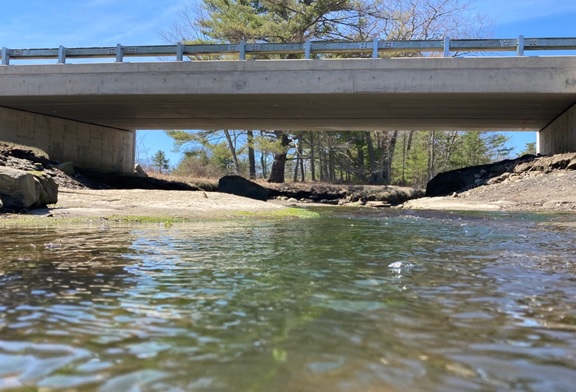Maine's CoastWise Approach for Climate-Resilient Tidal Crossings
The Takeaway: After years of effort, Maine published the CoastWise Approach manual, a guide featuring best practices, decision-making tools, and a pathway for designing climate-resilient tidal crossings that are cost-effective and ecologically friendly.

Maine’s extensive 5,300 miles of tidally influenced shoreline faces a significant challenge from infrastructure that restricts tidal and river flow. This infrastructure harms sensitive habitats, including estuaries, salt marshes, and tidal wetlands, that provide storm protection, pollution filtration, and carbon storage. Rising sea levels pose a specific challenge, particularly in over 800 locations where roads cross tidal channels. Ninety percent of these tidal road crossings act as restrictions, putting both the wetlands and the communities that depend on the roads at risk. To mitigate flooding and safeguard these invaluable ecosystems, restoring tidal flow while constructing resilient and climate-ready infrastructure is essential.
To address this pressing issue, the Maine Coastal Program and CoastWise collaborated with more than 30 organizations to develop the CoastWise Approach, a manual for tidal crossing design. This manual is tailored for road owners, engineers, and others involved in replacing critical road crossings. The approach represents a collective effort to guide the preservation and resilience of Maine’s coastal ecosystems, transportation networks, and the communities that rely on them.
Background
Interest in advancing Maine’s tidal habitat restoration began in the early 2000s. Other states had made progress enacting new wetland laws and establishing standards for tidal restrictions when the Maine Coastal Management Program began exploring an approach that became known as “CoastWise.” In Maine, large-scale tidal flow restoration projects face challenges. Although achieving full tidal exchange in salt marshes is important, this work can raise flood risk upstream, requiring careful planning and partnerships. These planning and design phases are costly and time-consuming, and ensuring long-term maintenance can be difficult.
Also, the initial costs for CoastWise projects can appear to be considerably higher than typical culvert replacements when co-benefits—such as reduced long-term maintenance expenses—are not included in the projections. CoastWise guidance for crossing size and design (with a recommended design life of 75 years) is the solution for long-term sustainability. In contrast, conventional crossings would need frequent upgrades and maintenance, resulting in similar costs over time with fewer ecological benefits than CoastWise projects. Overall, CoastWise guidance for sizing crossings is the best way to ensure long-term climate resilience.
Maine’s work to balance road infrastructure maintenance and tidal wetland protection through the CoastWise Approach can help build a sustainable future for coastal communities and ecosystems; the manual will serve as an invaluable reference for years to come. CoastWise partners continue to give presentations on the manual, assist towns and others with CoastWise projects, and collaborate on grant proposals for planning, design, construction, and monitoring.
The CoastWise manual offers key principles for tidal road crossings, including:
- Know Your Crossings: Identify vulnerable tidal crossings.
- Ask for Advice: Seek guidance and resources.
- Engage Qualified Engineers: Ensure tidal-specific expertise.
- Encourage Local Participation: Include communities in the design process.
- Start with Sea Level Rise: Select based on risk.
- Identify Low-lying Features of Concern: Consider vulnerability.
- Establish Clear Objectives: Define clear goals.
- Size Crossings for Resilience: Ensure unrestricted tidal flow.
(2023)
Learn more:
- CoastWise Approach Manual (PDF file, 7.3 MB)
- CoastWise Overview (A printable version of this page, PDF file, 2 pages, 1.9 MB)
- CoastWise Topic 1: Selecting a Sea Level Rise Scenario (PDF file, 5 pages)
- CoastWise Topic 2: Establishing Crossing Project Objectives (PDF file, 5 pages)
- CoastWise Topic 3: Modeling for Crossing Design Evaluation (PDF file, 3 pages)
- Maine Tidal Restriction Atlas
Partners: Bates College; Bear Creek Wildlife Sanctuary; Biological Conservation; Bowdoin College; Casco Bay Estuary Partnership; Columbia University; Downeast Salmon Federation; Goddard Space Flight Center; Great Bay National Estuarine Research Reserve; Inter-Fluve; Kennebec Estuary Land Trust; Maine Audubon; Maine Coast Heritage Trust; Maine Coastal Program; Maine Departments of Marine Resources, Inland Fisheries and Wildlife, Transportation, and Agriculture, Conservation, and Forestry; Maine Geological Survey; Maine Ecological Restoration Division; Maine Natural Areas Program; Massachusetts Department of Fish and Game; Massachusetts Office of Coastal Zone Management; Midcoast Conservancy; The Nature Conservancy; New Hampshire Coastal Program, New Hampshire Department of Environmental Services; New Hampshire Fish and Game Department; U.S. Army Corps of Engineers; Federal Highway Administration; U.S. Fish and Wildlife Service; U.S. Geological Survey; National Aeronautics and Space Administration; National Oceanic and Atmospheric Administration; University of Copenhagen; University of Maine; University of New Hampshire; University of New Orleans; University of Rhode Island; VHB; Wells National Estuarine Research Reserve; Woods Hole Group
PRINT